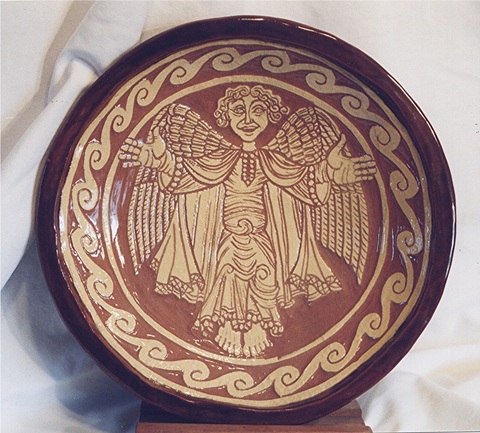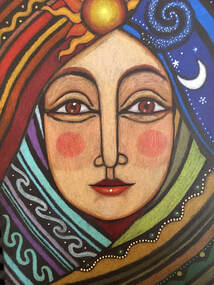Sgraffito Pottery

The word "sgraffito" means "to write or to mark," as we do when we write. It comes from the same root as "calli-graphy," beautiful writing.
In the later Middle Ages and into the Renaissance, nobles imported luxury goods from the Middle East and North Africa, and North African and Spanish potters and artisans were hired to come and work in Italy and Venice, as well as Byzantium, because of their mastery of various technical skills. Muslims were forbidden to eat from metal, so decorative glass and ceramics were highly developed in Muslim areas. As the Reconquista of Spain progressed, Spanish Muslim potters fled to North Africa, and to Italy and Byzantium, where their knowledge merged with the techniques of local potters to create new and exciting styles of pottery for Renaissance patrons of art. The Muslim, or Moorish, artistic styles of Spain are described as Hispano-Moresque.
The two most striking innovations in Renaissance pottery in Italy were sgraffito, and maiolica or majolica.
In southern Italy, the technique used for decoration was maiolica, in which coloured minerals are painted onto a white tin glaze. It's very difficult to get the firing temperatures and times exactly right, and coloured clays don't look the same unfired as they do fired, so this is both an art and a science. Maiolica has been collected and studied extensively by historians and art lovers. Sgraffito, on the other hand, is relatively unknown and unstudied. It photographs really well, though, so you can find lots of pictures of it, but very little information.
The technique of sgraffito is simple, although painstaking. You make a pot out of one colour of clay, let it dry out a bit, then paint it with a layer or two of a different colour of clay. You let that set up until it's what potters call "leather hard." Then you cut through the top layer of clay in a design. The contrast between the painted layer and the pot itself is what creates the decoration. In the banner photo at the top of this page I've used a detail of a sgraffito plate I made, before it was glazed. You can see the scrape marks made as I scratched through the white clay into the red clay below it.
This technique has been used many times throughout history, but it goes in and out of fashion. It hasn't been used extensively in European pottery since the 17th century.
Byzantine potters used sgraffito to decorate their pots, using designs they saw in nature or copied from Islamic pottery. Spanish potters were also using sgraffito. Between the 1450s and 1600, when the Moors were forced to convert to Christianity or leave Spain, Spanish potters fled to Italy. Meanwhile, potters in Northern Italy were already using sgraffito decoration.
We do know that potters were as highly regarded in the Renaissance as painters. Many famous painters designed pottery, and many potters were also painters. Pottery had the advantage over painting of being portable (oil paints were just being invented, so painting was mostly still done directly on walls) and permanent. Pottery was purchased as a pure luxury item. There are prints from the time of people eating a gourmet meal off of metal plates, while they admire expensive pottery displayed on a linen-draped table in the middle of the room.
One reason Italian potters did sgraffito was that they wanted a nice white surface to decorate, just like porcelain, but the only white clay they had wasn't strong enough to make plates out of. So they made their plates and bowls from their good old stand-by red clay, and coated it with white slip (liquid clay) to get the prized white ground to decorate.
Potters in the Renaissance glazed their sgraffito with lead glazes. A lead glaze fires clear, with a thin bright surface that doesn't obscure the colours underneath.
Food Safety with Lead Glazes
As we know today, lead can leach into food if acids in the food or liquid eat away at the surface and dissolve the lead. If a lead glaze is fired to a temperature above Cone 04, the lead burns off and the glaze is food-safe, but this was not known during the Renaissance. Modern potters have the ability to regulate temperatures exactly, but even so, not all brightly coloured pottery is safe enough to eat off of. This is why we're cautioned about pottery purchased in Mexico and other countries where standards of production may not be guaranteed. Unless a piece of pottery has either a stamp or a sticker certifying that it's food-safe, put your gorgeous Mexican bowls on the wall as decoration.
My Sgraffito Pottery
Once I discovered sgraffito pottery, it became my big love as an art form. It combines graphic arts with pottery, and lends itself both to pictures and to decoration, as well as geometric designs. I initially researched sgraffito when I was asked to participate in a living history display to honour the Leonardo da Vinci exhibit at the Royal BC Museum in 1998.
I do mainly sgraffito plates. It's easiest to do it on a flat surface rather than on a curved surface. And it shows off the workmanship better. I use mainly red clay for the pot and off-white for the surface, but occasionally I reverse it.
I use designs from Renaissance and other sources, but have started branching out on my own. I usually fire the plates 3 times: once to bisque temperature, then I glaze the underside and fire the plate to Cone 6, and finally, I glaze it with a commercial food-safe lead glaze and fire it again to Cone 03.
While it's not authentic, I buy lead glazes. Nothing can give you the same thin glaze and brilliant transparency a lead glaze can. But there are lead glazes that are food-safe when fired hot enough (above Cone 04) to burn off the lead.


